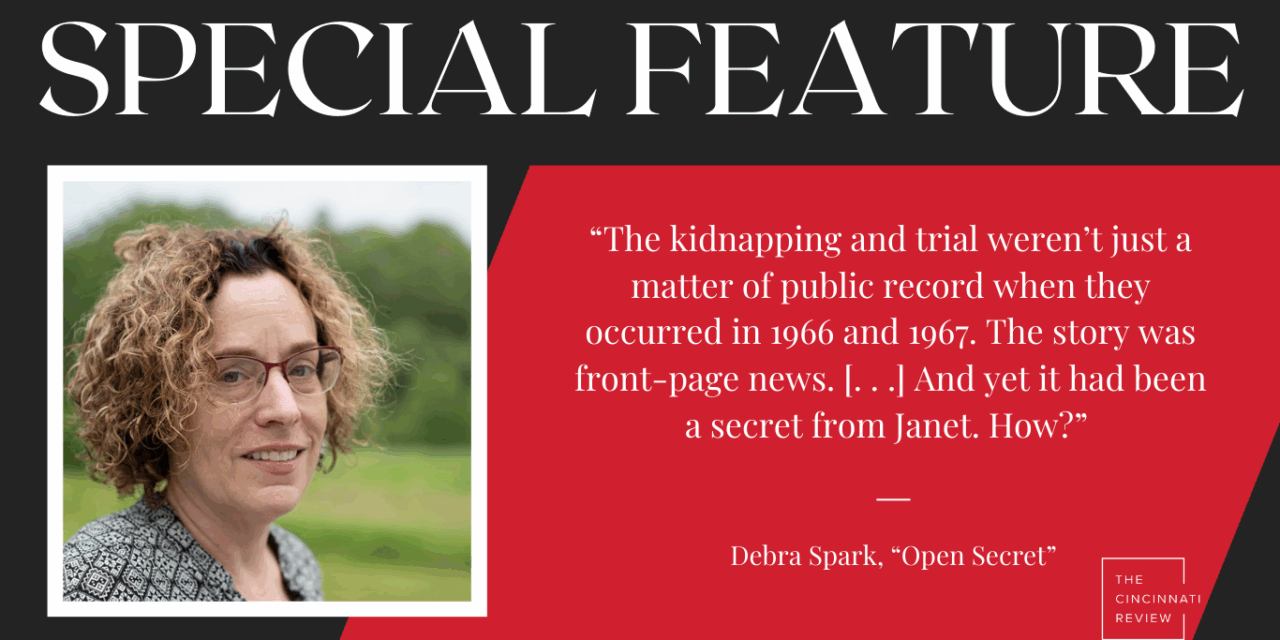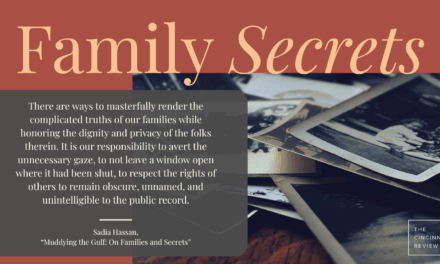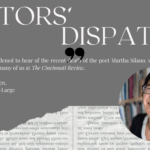
photo credit: Michael Harris
Managing Editor Lisa Ampleman:
This essay’s “I” speaker doesn’t emerge until about halfway through, which fascinated me as a craft choice when I first read it. Much of today’s literary nonfiction is memoir-based, exploring important topics, but this piece takes a step back and tells the story of someone else, a woman named Janet, who learns an important story herself, about her mother’s past. The essay unfolds with careful research and tact, with a mission to challenge what we know about each other and what we keep secret, intentionally or not.
Writer’s Note:
This piece is part of a series of essays I have been writing about life-changing coincidences and their aftermath. I am focusing on those coincidences that allow me to explore a larger social justice, moral, or philosophical issue. Here, the coincidence is pretty minor—something that happens in a dental office—but the secret that was then revealed was major. I was honored to be trusted with this story and excited by the sleuthing, which took me down unfamiliar paths to courthouses, prison letters, and ancestry files, necessary to write it.
Open Secret
One day in 1989, Karen Malcolm[1] was at work when a woman started talking about Margie Carbone. Karen is a dental hygienist and so had her implements in the woman’s mouth as she agreed that Margie was fantastic, a kind person with fortitude and an almost innocent demeanor, one of those mothers who always knew what her kids were up to, even now that they were grown. Plus she made a mean scallop-noodle casserole.
“And she’s been through so much,” the Mouth said before spitting.
Karen didn’t know exactly what the Mouth—she no longer remembers the patient’s name—was referencing. Margie was a devout Catholic with a mechanic husband and six kids. The youngest were twins, one of whom was Karen’s dear friend Janet.
The Mouth’s manner wasn’t gossipy. She spoke as if musing over something that was common knowledge, so Karen nodded to suggest she understood, until the story came out.
Twenty-three years earlier, in 1966, when her children were all under eighteen, Margie had been abducted after a PTA meeting at the Catholic church where two of her sons attended parochial school. She’d been forced to drive from Lewiston, Maine, to Berlin, New Hampshire, where she’d managed to save herself. She subsequently testified against her captor, who was sentenced to life in prison.
* * *
After the appointment, Karen told her coworker Diane what she’d learned. Diane’s memory is that she also worked on the dental patient and heard the story when Karen did. Neither woman is 100 percent sure about how the day unfolded, but they both remember that after, they worried over what to do. They agreed that there was no way their friend Janet knew this upsetting bit of family history. “We had big heart-to-hearts about each of our lives,” Diane remembers of the years when the three women were all in their twenties. If Janet knew about this, she would have told them.
Eventually they decided to ask Janet to meet them for dinner at a local restaurant. Over the phone, they said they’d heard something about her mother that they wanted to share. At least if they were the ones who told her, Karen reasoned, Janet would be learning it from people who loved her.
* * *
Janet—who even today at sixty is a fashionable, vibrant, plain-spoken redhead with dramatic long curly hair—arrived at the restaurant already upset. “Karen,” she said, “What the hell is going on? Who’s talking about my mother?”
Karen and Diane told Janet what they’d heard, and Janet reacted as they suspected she would. Was it true? If so, how could she not know something like this about her own mother? Janet didn’t stay for dinner but immediately drove over to her parents’ home. She found her mother (then sixty-five) in her bathrobe, on the sunporch that had been converted into a “retirement room” for her husband, Harry. She was watching Dallas on a small TV.
“Janet Rose, what’s going on?” her mother asked, instantly worried by her daughter’s distraught manner.
All these years later, Janet wonders if her mother thought she was pregnant.
“Mom,” Janet said, “were you abducted?”
“Oh my God.” Her mother didn’t add anything for a moment. “Oh my God, Janet.” The “oh my Gods” were a clear affirmative.
“You know what?” Janet said. “We don’t have to talk about this. I’m leaving. I have to leave now.”
“Janet, please.”
“No, no, no. I’m really sorry I brought this up. I’m so sorry. We don’t have to talk about this.”
Janet left. It was nine p.m., and she was confused. Maybe she shouldn’t have asked her mother about something so painful. Yet she did need to talk, so she drove back to the hair salon in Auburn, Maine, where she worked. Her friend Lorraine lived just upstairs.
Janet knew her friend to be an early riser but knocked on her door all the same. Lorraine poured Janet a drink and tried to calm her down. “How did I not know this?” Janet wondered. “How did somebody not tell me this?”
Lorraine said the obvious: “She probably wanted to protect you.”
After about an hour, Janet drove back to her parents. Her mother greeted her at the door, rosary in hand, and said, “I’m going to tell you what happened to me.” Janet was more composed now and insisted it was okay, her mother didn’t have to talk. But her mother wanted to. She began by saying, “I went to a PTA meeting. I was coming out. It was around Thanksgiving, and I had a turkey.” In fact, she had won a turkey earlier in the evening at a school raffle. A night that began with good luck ended with terrible luck. She was forced to drove south by a stranger, she said, by “some guy who had too much to drink and just probably was humiliated by some other woman, and I had to drive all night, and it was awful, but I lived and I got through it and I’m home and it’s okay.”
Now Janet felt guilty for asking. She started to apologize, adding, “I love you and I’m glad you’re here.”
“And that’s why every Thanksgiving, Janet,” Margie said, “we always stand around the table. We hold hands and . . .”
Cry. The word her mother was looking for was “cry.” Everyone always cried in her family around Thanksgiving. Not that Janet had ever known why.
Aside from clarifying the longstanding Thanksgiving weeping, the story explained other things: why Margie flipped out when Janet stayed out late as a teen, why she always slept with a baseball bat and whistle, and why she refused to visit Janet the single year that Janet had lived in Manchester, New Hampshire. The drama of Margie’s terrible night had ended in that city’s police station.
* * *
Within the week, Janet approached her father at her parents’ home to say, “I am kind of a little pissed right now.” Harry looked up, shocked: Janet was not in the habit of talking to her father like this.
“I just learned what happened to Mom.”
“What happened to your mother?” he asked, a genuine question.
You might think Margie would have mentioned that she’d told Janet about the kidnapping. Or that there had been an emotional dustup with one of the kids that she’d managed to settle. But apparently not. Which was in keeping with how Janet perceived her entire family as operating: They never talked about anything emotionally weighty. Though that didn’t mean they weren’t affectionate. Harry would daily ask Margie, “Did I tell you how much I love you today?”
When Harry realized what Janet was referring to, he said, “Oh God, Janet, nobody ever told you about that?” Janet thought he was almost making light of it, but when he saw the look on her face, he started to offer an explanation: “Janet, you have to understand, it was a terrible time for us, and then the rape.”
“The rape?”
“Oh God, you didn’t hear about that?”
“No, Dad. Mom didn’t tell me that.”
Her mother had neglected to mention quite a few details about the night she was kidnapped. Janet’s conversation with Margie lasted no more than fifteen minutes; the one with her father was even shorter.
* * *
Afterward, Janet went to the Auburn Public Library to see what she could learn. Here was another shock, but one that explained why the Mouth’s manner wasn’t gossipy when she was talking to Karen at the dental office: The kidnapping and trial weren’t just a matter of public record when they occurred in 1966 and 1967. The story was front-page news, sometimes even the day’s banner headline—“Auburn Mom Tells of Kidnapping”—crowding aside the latest from Vietnam. Janet found articles about the crime on microfiche but couldn’t absorb the content of what she read. She only registered that none of this was a secret.
And yet it had been a secret from Janet. How?
No one had “ever said a word, slipped, asked me about it. It blew me away,” she says now. She and her family were well known in their community, had a wide circle of friends. Perhaps out of respect for her parents, none of those people ever said a thing, whether because it was a purposeful secret or an organic one, time passing and people simply never wanting to bring the incident up.
Janet felt horrified about what her mother had experienced and proud of her for saving herself and for not letting the incident destroy her. Some of her siblings (six to sixteen years her senior) must have known, given the age they were at the time of the crime. What about her twin brother, John? Did he know? Was she the only one who had been kept in the dark?
Janet wasn’t sure what to do. She’s a talker. Others in her family are not. What might be old news for them was fresh information for her, and she needed help processing it. Despite her family’s roll-the-eyes attitude about therapy, she began talking with a professional to understand what her mother suffered and why it was kept secret. She actually thought it might help everyone to talk, but that just wasn’t where her family was.
* * *
It took decades for Janet to learn all of what happened.
The basic facts are these: On November 22, 1966 at around 9:30 p.m., Margie, one of her son’s teachers, and that teacher’s husband left a long PTA meeting at Saint Joseph’s Catholic Church. The three departed by a side door, Margie heading for the station wagon that sported her husband’s business logo. She’d parked a car length’s off Main Street on Elm, in the shadow of a building. The teacher chided her husband for not carrying the turkey for Margie, but rather than offering to help, he said Margie had twins at home so likely could lift a turkey.
Margie’s twins—Janet and her brother—were two and a half that year. (The older kids were eighteen, fourteen, eleven, and eight.) The turkey was, indeed, quite heavy. Sixteen pounds. All the same, Margie had hauled it this far on her own, so she told the teacher and her husband that she could manage. She put the turkey in the back seat, got into the driver’s seat, and started her car. As she did, a man slid in next to her, so quietly that Margie did not even hear the handle of the passenger’s side door turn, or the door itself open. The man was simply suddenly beside her, showing her a gun and declaring, “This is not a toy. This is real. Don’t make a sound.” He told her she was going to drive where he said to, and that he would kill her if she tried to signal for help. Over the next several hours, he directed her down wooded back roads and through small towns, toward Berlin, New Hampshire. Twice, he forced her to stop by the side of a road so he could pull her by her ankles down onto the front seat of the car and rape her. Margie lost a shoe during the first rape—but so accurately remembered the drive that a few days later, she, Harry, and a police sergeant neighbor retraced and documented the exact route, finding and photographing the missing shoe for the trial that was to come.
Her ordeal ended at two a.m.
* * *
As Janet got older, she not only never broached the issue of that terrible night again with her parents, she felt she couldn’t ask her siblings about their memories or even let them know she now knew. She thought it best to accept that others handled things as they did and to put it out of her mind. This strategy worked for long stretches of time, then something “would kind of start poking at me,” she says, and she’d try to learn more about what had happened.
But by the time she wanted to do some real research, she couldn’t find much. There wasn’t anything online, and increasingly, there were fewer and fewer people to ask. Janet’s parents died in their seventies, her father on the golf course. On his way out the door to play his beloved game, he’d asked Margie, “Did I tell you how much I love you today?” It was the last thing he ever said to her. Three years later, Margie died of cancer.
Finally, when Janet was in her forties, she decided to reach out to Margie’s dear friend and confidante, Paula, who was then in her mid-eighties. Paula was similar to Margie in many ways—religious with many children, including a set of twins. Janet was specifically hoping Paula could tell her how her mother had managed to save herself on the night of the crime.
* * *
Margie had tried initially to bargain with the man in her car, telling him that she had six children who needed her. She offered her purse and the car itself, in exchange for being left alone. Her captor had a .22-caliber pistol and said that he had a second gun that he’d use if she tried to grab the first. He told her he’d killed before and wouldn’t mind killing again, and if she was indeed worried about her children, she would do as he said.
So she did.
Over the course of the drive, whenever the man thought people could see into the car, he would put his head on Margie’s shoulder, and she could smell the alcohol on his breath. Other times, such as when they passed a policeman by the side of the road, he put his gun to Margie’s neck, so she would not flash her high beams or in some other way signal for help. Somewhere around 1:30 a.m., he began to intermittently doze. His larger plans (for Margie, the night, himself) were unclear, but he spoke of having paid two people $1,000 for an airplane in Stewartstown to take him to Canada.
Most of the roads the man directed Margie down were dark, but then they came to Berlin, which was better illuminated. By this point, the man seemed to have fallen asleep, so when Margie saw two police officers at a filling station, she waved to get their attention. Initially, they did not realize she was waving out of distress. She signaled again, and this time, they thought maybe they should pay attention. They started their cruiser, just as Margie turned the station wagon around and drove back down the street toward them. Her car bumped over a curb as she pulled into the filling station, but the man didn’t wake at the jolt. She abruptly stopped the car, though, stripping the gears, which did wake him. “Don’t do anything crazy,” he said. But by then she had already flung herself out of the car, scrambled to the far side of the police cruiser, dropped to the ground, and cried, “He has two guns on him. I wish you would get him.”
Janet had the impression from what she had been told that the police had doubted her mother’s story at first, but there is no suggestion of that in the trial transcript. Instead, one cop stayed with Margie, while the other pulled a gun on her captor and made him get out of the car with his hands up. They took him to the police station, asking Margie to follow.
There were two policemen. You’d think they’d handcuff the man so someone could accompany her to the station. Instead, after her long, traumatic night, Margie had to trail the cruiser through a dark town she did not know.
* * *
After Paula died in her nineties, Janet put the story to rest. Later, in her fifties, she was ready to make another push for information. She started to wonder specifically about what had been reported in the newspapers, but she couldn’t find the microfiche articles anymore. She asked one of her clients, then a (well-coiffed!) local news anchor, now in a different media position at a Maine liberal-arts college, if he could help track down the coverage. He said he could, though it might take some time.
And, indeed, the search wasn’t the open-and-shut Internet effort that sometimes is all that is needed for historic research. Six months later, though, having used his professional contacts, he was back at the salon with a yellow envelope. It contained about twenty-five pages, twelve articles in all, local coverage of the crime, along with his advice that Janet be with someone when she read what was inside. Some details might surprise her. Janet took the envelope and then waited a year to open it. Or maybe longer. Now, she can’t remember the timeline. For all her curiosity, she, like her family, wasn’t always sure she wanted to look at this upsetting part of the past.
But finally, one day during the pandemic, when she was alone—so much for her client’s good advice—she opened the envelope and read.
* * *
There wasn’t too much in the envelope that Janet didn’t already know, but she had been wondering about the name of the perpetrator—and there it was. Bruce John Grasso. He was described as a transient from West Glover, Vermont. It’s unclear why he even was in Maine on the night of the crime or why he was traveling with a gun or why he kept telling Margie during that drive to New Hampshire about that plane that was going take him to Canada, a story his own lawyers called “wild and impossible” and that made them think he was “presently insane.” They asked for a pretrial psychiatric evaluation.
Janet had learned from her mother’s friend Paula that Bruce had been insulted by a stripper at the Holly, where he was drinking in the hours before he got into Margie’s car. Only how did Paula know this? A supposition passed on from Margie? It doesn’t seem like something Bruce would have shared as he was terrifying Margie, especially as Margie had tried to talk to him during the drive, asking why he was doing what he was doing and whether he had faith in his life. He’d responded, “I don’t have to talk to you.” Still, Paula told Janet the stripper’s insult occasioned Bruce’s desire to revenge himself on women, starting by attacking a random woman near the Holly.
The Holly was a dive that everyone of Margie’s generation . . . and Janet’s . . . knew. It was “gross,” Janet remembers, a bar abutting a hotel, though the bar was also a strip club and the hotel also a whorehouse. It wasn’t hidden away, allowing patrons anonymity. Instead, it was on a corner of Main Street, a five- or ten-minute walk from Saint Joseph’s, where the PTA meeting with the turkey raffle was held.
The Holly no longer exists, but an old photo of the place is posted on the Facebook page “Old Pictures of Forgotten Maine.” In the image, a vertical business sign with a giant arrow points to the front door, as if people might be inclined to enter a different way if not for the helpful hint. The brick building has a row of upper-floor windows filled with tattered white curtains and surrounded by paint-chipped frames. The bar below has a broken marquee sign, the word “cocktails” a lucky survivor of the damage. The black facade of the neighboring “LEO PAR ROOM” has, as one wag comments on the Facebook page, lost its spots.
There are hundreds of additional comments on the Facebook page, some suggesting the low-life fun on offer at the Holly or joking about strippers. Many remember that locals used to speak of “Getting Jolly at the Holly,” and one person elaborates by writing, “Someday the Wicked Good Band may record the classic, ‘Getting’ Jolly at the Holly,’ with the lyrics ‘listen to me people and a story I’ll tell ‘bout a little place of bidness (sic) called the Holly Hotel / they got mirrors on the ceilings, they got mirrors on the floor / if you’re carrying a weapon you got to leave it at the door. . . . ’ And so on and so on.”
Not too many people offer posts that register the likely circumstances of a person choosing sex work for employment or electing to purchase sex rather than acquire it through other means. One person remembers, with what I hope is ironic sympathy, “The girls would come up to the Emergency Room where I worked. Sometimes with their Entertainment Coordinator. . . .”
The Holly sounds like the kind of place where rooms were rented by the hour not the night, but Bruce John Grasso slept there the night before his crime. At his trial, the manager of the Holly testified that on November 21, 1966, she “accepted a diamond ring from him as collateral for a room after refusing to accept a check which he offered.”
The next day Bruce had cash, which he exchanged for the ring before he started drinking at the Holly’s bar around seven p.m. The manager told the bartender to cut him off at around nine, “as he was getting noisy,” she testifies. She did not perceive Bruce as drunk, just “feeling good,” but she adds, he “was beginning to disturb and interrupt the show and we don’t tolerate that.”
Within fifteen minutes of leaving the bar, he was stepping into Margie’s car.
* * *
There was something else Janet could go looking for, if she wanted to know more about her mother’s experience. She could track down the case files and trial transcript, almost one thousand pages of material. Not that she knew this information was available, but I found it after she told me her mother’s story initially while she attended to my hair—she specializes in the curly hair we both have—and then with some trepidation, once I asked if I could write about what had happened.
She wasn’t sure how her family would feel. Maybe use a pseudonym, Janet suggested, then wondered if it wouldn’t honor her mother to use her real name? After all, Margie was so brave in saving herself, so strong in living her life as she did, in not letting those five horrible hours define her. There was no way Margie was going to let that creep keep her from her children, and no way she was going to let him go on to hurt other women. Or that’s how Janet interprets her bravery that night and later at the trial.
Would Margie be honored to be written about? She didn’t even like to be thanked for her extensive charitable efforts in the community. That was for God, not others, to note. It took away from the “goodness” of being good if you did it for praise.
Once I found the trial transcript—in the National Archives in Kansas City; the pages had been slated to be burned, then somehow escaped that fate—I sent it to Janet, as well as the case files for a different Grasso trial, a car theft, whose files came from Boston. Some months before he’d kidnapped Janet’s mother, Grasso had taken a car from a Vermont used-car lot for a test drive and simply never returned it, later selling the car (through a friend) to the owner of a Massachusetts convenience story for $47 dollars and $3 of store products. (I imagine, for some reason, $3 worth of Slim Jims). I also sent Janet copies of Grasso’s multiple appeals of his convictions and his complaints about the related charges that never went to trial. One was for being a felon with a firearm, the other for transporting stolen property across state lines when he forced Margie to drive south. Janet wanted all that material, but (at least as of this writing) has not looked at any of it.
She wants to know.
And she doesn’t.
She also wants to honor her mother and not upset her siblings. How to do both? Janet has no idea how her siblings would feel about making this story public. Or public again. Maybe it would be fine with them, but just in case, we’ve settled on pseudonyms for this essay, to save her the anxiety of having to ask.
* * *
In her 2019 Nobel Prize speech, Olga Tokarczyk said, “A thing that happens and is not told ceases to exists and perishes.”
This is the sort of quote normally trotted out “for” the silenced, to remind them to speak up, to own their life stories. But read out of context, the quote suggests something different. If Margie and Harry never spoke of the abduction, could the five hours of Margie’s life spent in the company of Bruce John Grasso cease to exist and perish? Might that not be a positive?
Yet in her speech, Tokarczyk is not arguing for silence, given that “he who has and weaves the story is in charge.”
Kerri Arsenault’s Mill Town: Reckoning with What Remains (St. Martin’s Press, 2020) is a book about the secrecy around mill pollution in her hometown of Mexico, Maine, where mills employed and then killed (through cancer) so many of the town’s inhabitants. “What you don’t know won’t hurt you,” Kerri Arsenault reports her mother as always saying offhandedly, then adds, “She was dead wrong.”
We have moved from a generation of people who believed in keeping quiet to a generation that believes in openness. In “A Mosaic of Transmissions After Trauma,” a chapter in M. Gerard Fromm’s Lost in Transmission: Studies of Trauma Across Generations(Karnac Books, 2012), Howard F. Stein writes, “What has consciously been banned from existence returns as a ghost, usually in the form of enactment. Those who must not acknowledge their grief find the loss has come to possess them.” In other words: Pain outs somewhere. Like: You don’t talk about it, but you weep at Thanksgiving. Or sleep with something you can use as a cudgel for the rest of your life.
And why don’t people acknowledge their grief? Because it is too painful? Too horrific? Because someone does not want them to do so? Because it would upset a partner? Because they have to focus on other things, like taking care of their children? Because they just don’t want to think about it?
Things unspoken become unspeakable, the poet Adrienne Rich wrote.
That doesn’t sound good.
And yet. In Gwen Strauss’s book The Nine: The True Story of the Band of Women Who Survived the Worst of Nazi Germany(St. Martin’s Press, 2021),a man considers his aunt’s silence about her experience at the Ravensbruck concentration camp and the subsequent Death March, and wonders, “How can a parent talk about something like that?”
Indeed.
As a parent myself, I do not know when I’d decide to tell my child about something like what Margie experienced, yet I understand Janet’s complicated feelings about not being told. I lean toward Robert Lowell’s question in his poem “Epilogue,” “Yet why not say what happened?” I believe that painful things, when shared, are at least held in common, which somehow lessens the weight and even offers comfort. Is that a fanciful idea? Could you be a writer, of any kind, if you didn’t believe that on some level?
* * *
As children, we’d rather not know anything about our parents’ sexual selves (the good and certainly the bad) and we don’t want to see our parents (or anyone we love) in pain, so it’s clear why Janet both wants and doesn’t want more details about what her mother went through. The 1967 trial isn’t explicit about the rapes in the way a contemporary trial might be. The fact of the physical attack is made clear, but no details are offered. Although there’s plenty in the transcript that’s discomfiting, more than anything else the pages reinforce Janet and her dental-hygienist friends’ sense that Margie was remarkable.
Reading from the distance of 2024, and with a layperson’s knowledge of court behavior, I am struck by how almost all the major speakers at the trial have moments of sounding like buffoons, save Margie. And how there are weird lapses on both the prosecution and defense sides, though the prosecuting attorneys are certainly more accomplished than the defense. As an indigent, Bruce Grasso is provided with a lawyer who has recently passed the bar but never before tried a criminal case, a lawyer who notes that it would be better if someone else were picked for the task, though he promises to do his best.
Margie’s case is so strong that the prosecutors’ job is hardly difficult. Still, the lawyers never mention that the Holly show, during which Bruce became voluble, was a strip-club performance, which would seem relevant to his sexual aggressiveness.
As for Bruce’s two eventual defense lawyers, they spend most of the trial objecting to technicalities, such as not being able to see certain documents before trial, often documents that don’t even appear to exist. They pursue long inquiries into irrelevancies: Did the bartender at the Holly serve Bruce three or four drinks? What was the exact route of the drive? Wouldn’t someone wake up if his or her car drove over a six-inch curb? None of it seems to the point at all.
When Margie notes that she was relieved to see a nun on entering the hospital where she went after the Manchester police station for an exam, the defense objects, saying this mention of a nun will unfairly play to the religious feelings of the jurors. To this, the judge says there are no Catholics among the jurors. The defense quite rightly points out that the jurors have not been polled on their religious convictions.
Though Margie was weeping when the hospital doctor first saw her, there were no signs of struggle on her body, and the vaginal exam that he conducted produced four to five dead, not living, sperm. Given this, the doctor testifies there is no evidence for rape, though he allows that such a thing is hard to determine. In other words, it is conceivable the sperm were left over from consensual activity with her husband. This said, Bruce’s large size is mentioned twice during the trial, and the .22 caliber that he had on him when he stepped from Margie’s car is presented as evidence. It is plain why Margie would not have struggled.
The defense seems to think the doctor’s testimony will serve them well, so they offer the jurors no way to understand the other facts about the night in question. Of course, Bruce does not need to speak at his own trial, and jurors are not to infer anything from his silence. As a defendant, he doesn’t need to prove himself innocent. Still, the defense never offers a plausible or in fact any conceivable counternarrative to Margie’s account of the evening.
As for Margie, she reads as measured during the trial, answering every question with precision. She never contradicts herself or stumbles. When the defense tries to make an issue of the fact that she first said her car was parked on Main Street when it was actually parked on Elm, she clarified that she was parked a car’s length away from Main on Elm and did not think those reading her testimony would know Elm, which is why she said what she did.
The 1967 newspaper reports convey what the transcript does not—that as articulate and clear as she was, at times she dabbed a handkerchief to her eyes as she spoke, and she was red-faced and swollen-eyed in court. After her testimony, she was sufficiently upset that the prosecution changed plans, deciding not to call Margie’s husband to testify so the couple could be alone together.
* * *
The story of the kidnapping helped Janet understand another moment from her past that had previously puzzled her. On her prom night, Janet had been invited to a gathering at the home of the family that ran the local newspaper.
Her father had said, “You are not going into that house.”
Her mother said, “Harry, she’s going, and we’re just going to drop it.” At the time, Janet wondered what this was all about. Years later, she learned her father had asked the local newspaper not to include certain details in their coverage of the crime and trial.
Janet says, “He was, like, ‘Just try to understand. I have kids I’m trying to raise. This is very traumatic, and I just don’t want you writing about everything you’re going to hear.’”
That her father held a grudge speaks volume. There are no prurient details in the paper, certainly not the kind of details that come out in present-day cases of sexual violence, and certainly not anything like the details I have included here (about the vaginal exam and about being pulled by her ankles down onto the car seat). The newspaper account just has verbs; the most shocking thing for a child to read would be that their mother was “sexually assaulted” and then (perhaps this is what the father objected to) “ravished not once but twice.”
What the paper does have is the prosecutor closing his case by describing Margie as a decent, reputable mother of six, who was attending to the needs of two sons on a night that her husband stayed home to care for the little ones. He adds, “She was a gallant, proud woman testifying before you because she had to, not because she wanted to,” and someone who must now “live with this for the rest of her life.”
But is it possible that she didn’t live with the night as much as we might think? Could that be behind her and her husband’s silence, not damage but the decision to somehow bracket and discard this experience? Maybe what Margie lived in the aftermath of this terrifying experience was more her sense that the two policemen who she saw at two a.m. were “divine intervention,” which is what Margie’s friend Paula told Janet, and what Paula herself believed. Many small towns close down by nine p.m. Ordinarily, at least in 1966, you would not see policemen in front of a filling station so late. This was God coming to the rescue.
The skeptic might point out, of course, that the Divine could have intervened a bit earlier in the evening, that God might have prevented Bruce from sliding into the car with Margie in the first place. But that was not how Paula and Margie, with what Janet describes as their “incredible faith,” interpreted things.
The point Janet takes from the story, and the point she would like to celebrate, is simply that her mother lived.
* * *
With Bruce John Grasso represented so poorly, I couldn’t help but wonder who he was, how he came to choose to do what he did on November 22, 1966. On that night, he was a thirty-three-year-old unemployed, divorced father of four, his only reported asset a 1953 Chevrolet station wagon worth $50. His life, at least as publicly documented, never seems to have gone all that well. His mother died when he was thirteen, his father a year later. He did not graduate high school and by seventeen was working as a hired hand for a family in Vermont.
I don’t know what his first criminal activity might have been, but when he was twenty-six, he confessed to public intoxication and breaking and entering, a one-night spree that had him clumsily hitting up three spots in the town of Orleans, Vermont. As the Newport Daily Express reported on Nov 1, 1958, “The burglar had fallen into a grease can near the window of Grace and Bob’s restaurant during his marauding.” Greasy footprints were left all over the restaurant floor, and though Bruce stashed the “loot,” which included guns, liquor, and cold cuts, in a duffel bag in the woods, he didn’t think to change his clothes. (“Lard trips up Orleans thief,” another local headline gleefully proclaimed.) A high school girl cracked the case, simply because she spotted Bruce in grease-spattered clothes in the local market, using silver coins he’d stolen the previous night.
Bruce refers to “family and friends” in his many, many appeals of his convictions, and his numerous complaints about the slowness to try the other charges, noting that because he is imprisoned in Atlanta, they cannot visit to offer support and help him secure new legal counsel. Still, he is never specific about who these visitors might be, though he briefly mentions a brother. For a long time, I assume this brother is a half brother fifteen years his senior who was divorced by his wife for “extreme cruelty.” The charge makes me wonder if meanness was somehow in the family line, given that in 2022, Bruce’s thirty-four-year-old granddaughter murdered a seventy-one-year-old man in his own apartment by stabbing him multiple times in the head before stealing his car and fleeing to Massachusetts.
Or maybe the Grasso family issue was mental health.
Or misfortune.
Or poverty.
Or all of the above.
The physician who examined Bruce two months before his April 1967 trial found him fit to serve trial but added that the “most appropriate diagnosis” for Bruce would be “Sociopathic Personality Disturbance Antisocial Reaction, manifested by emotional immaturity, lack of sense of responsibility, poor judgment, disregard for the usual social codes and inability to profit either from experience or judgment.”
Such a determination does perhaps explain his correspondence, which includes his indignant missives to the US District Court saying he has a right to have a witness in his favor at his trial (true enough) and then proposing several different fellow prisoners, all of whom were in prison at the time of his crime, and one of whom was once on the FBI’s ten-most-wanted list.
He consistently sees himself as a victim, someone who almost lost his life for something he did not do, as he puts it at one point. In a letter of August 9, 1968, he writes, “I am doing my very best to be a gentleman about all this but I was handed such a raw deal by the court and the unscrupulous United States attorney last April 21st, 1967, and my legal knowledge has improved since then.” He then promises not to be such “a gentleman” if he does not get what he wants.
The appeal letters are usually polite, signed “Very truly yours,” as are his complaints about his right to a speedy trial for the co-indictments that appear to have dropped by the wayside once he is in prison. It is unclear why he presses for them to be heard. Is he simply writing to have something to do? He is correct that the trials are delayed overly long, and that his rights have been violated in that respect, but it isn’t in his own interest to have the cases heard. He’d almost certainly be convicted and receive more prison time, even though that time might be served concurrently with his life sentence, as is the case with his conviction for the Vermont car theft. Perhaps he presses the cases because he imagines a chance to escape while being transported to New Hampshire for the additional trials? He’s housed with criminals who have managed jailbreaks in the past, has even proposed one of them as a witness in one of the two cases he wants retried.
Buried amid his almost daily correspondence to the New Hampshire district court is a letter in which Bruce appears to try to bribe a judge by referring to the proceeds of an unsolved diamond-store robbery (perhaps that explains the diamond ring at the Holly) and a payment that he will offer the judge once free. The judge refers this letter to the FBI, who subsequently confront Bruce. He denies writing it, and the officials decide it isn’t worth pursuing, given evidence problems—the letter is in Bruce’s hand but his fingerprints aren’t on the letter—and given Bruce is already in prison.
Later, in a letter dated March 3, 1969, as he is inquiring about how to get a copy of the psychiatric evaluation from before he was tried for kidnapping Margie, Bruce writes the clerk of the New Hampshire court, “I have just made a Confession to a murder in Vermont State and the Honorable Judy Gibson, U.S. Dist Court. Dist of Vermont, has the presumption of my insanity or is in favor of same.” Bruce never sounds insane exactly, though he does sound like a man who never had sympathy for anyone in the world save himself.
In Bruce’s file, there is also a letter from his Atlanta cellmate, suggesting where $15,000 in jewels stolen from the Globe Store might be found. This is the same jewelry-store robbery that seems to be part of Bruce’s attempt to bribe a judge. More shockingly, the cellmate then suggests authorities look into the death of a certain man in Pittsburg, New Hampshire (the town where Bruce was born) in 1958 or 1959. The prisoner adds, “I am in the cell with a Bruce Grasso and he sure talks a lot.”
Did the authorities ever investigate this? Grasso was never charged with murder, not the one he supposedly confessed to in Vermont, nor the one his cellmate spoke about. You would think a man sentenced to life in prison who also committed one or more murders would actually serve life in prison. But Bruce didn’t. He was held without bail in Concord, New Hampshire, then incarcerated in federal prison in Atlanta after the 1967 trial. In 1974, he was transferred to prison in Marion, Illinois, and on February 1, 1986, four years before Janet even knew about the kidnapping, he was released.
He lived for under two years as a free man, then died when he was fifty-three “at a Manchester hospital after a long illness,” according to his obituary, which adds, “He was born in Pittsburg and lived in Manchester before moving to Barnstead this year. He worked for many years at Seal Tannery.” His three children, one stepchild, and twelve grandchildren, nieces, and nephews, are all mentioned in the write-up, as if he was a man embraced by family. There is even mention of a brother, not the older brother accused of extreme cruelty, but his father’s apparent son, though that son does not appear in the 1940s census when Bruce lived with his parents or in other records. All this suggests an answer to a question that stays with me as I read about Bruce and his crimes—Did anyone love him? Or even care for him?
I don’t know, of course, though someone cared enough to misrepresent his life in his obituary, as there was no time for him to work several years at Seal Tannery. The paragraph’s subtext is otherwise silence. Like the Carbone family, the Grasso family doesn’t want to talk about it.
Contrary to Bruce, Margie Carbone’s life contained much to celebrate. And Margie was talked about. A random patient at a dentist office talked about her, because she felt like talking about her, because there was something worth saying about this mother who was loved by so many. In all honesty, I can’t help but love her as I read her forthright testimony. I recall Janet pausing in her snipping of my hair to stand up straight, meet my eyes in the mirror, and tell me how she imagines her mother answering a question at the trial about whether the man who hurt her was in the courtroom. “Yes. He. Is,” Janet says in imitation of her mother and with so much force that it might be Janet herself who is testifying. As I think, in allowing me to write her story, and despite all her qualms, she is.
[1] Pseudonyms are used throughout this essay.
Debra Spark has published twelve books, including, most recently, the novel Discipline (Four Way Books, 2024). She teaches at Colby College in Maine.











